A stakeholder is any individual, social group, or actor who possesses an interest, legal obligation, moral right, or other concern in the decisions or outcomes of an organization, typically a business firm, corporation, or government. Stakeholders either affect or are affected by the achievement of the organization’s objectives.
That’s the stakeholder definition provided by Britannica.
If you wonder why you or anyone else on the product team should give a flying flamingo about stakeholders, think about historic breakdowns that happened because one person crossed the tipping point of their emotions.

Even a relatively small app coded by a team of one has more stakeholders than this single developer and is contingent on Conway’s Law:
Any organization that designs a system (defined broadly) will produce a design whose structure is a copy of the organization’s communication structure.
Conway, M. (1968). “How do Committees Invent?”
Open this article in a new tab to later check if my colleague did well breaking down this law:
A guide to the Packaged Business Capabilities for the C-Suite
There’s a deeper truth to Packaged Business Capabilities and software development in general, and what connects the two are people and their communication structures.
Plus, add https://teamtopologies.com to your reading list and dig into the stakeholders of my blog post.
Let’s Spell’em Out
Some might think that this text is a subject between just Makimo and me, right? But if we look carefully, this landscape is much broader and diverse, so let’s go wild and list some stakeholders! We’ve got Makimo, competitors, content creation PM, marketing people, all of my colleagues (especially Michał), project teammates (might be from other companies), Let the Tech Out podcast bestie, one cute Dutch/Caribbean guy, clients and their users, HR/accounting, the Academy, my students, friends, family and the dog, my neighbors, business books authors, technology providers, policymakers, our bank, AI engineers, me, our editor, and the reader.
Wait! What? That Many?
Yes, and I was even a little too frugal with the details! When you’re on the quest to identify your project stakeholders, consider who is interested in what you’re doing and who can help you make it or break it — even if helping means aborting the mission for the greater good.
Grab thick markers, post-it notes, or an online whiteboard, and set up a quick workshop with the project team to ensure that no stakeholder sneaks under the radar. Pinpoint individuals who are rooting for your project’s success (or secretly hope you’ll be struggling). Think about team members, end users, customers, sponsors, or even that vocal community group down the street. Next, button down who’s got the power to shake things up: this could be senior management, investors, regulatory bodies, or those crucial suppliers.
Then, break down your stakeholder list and really get to know these players. Who’s cheering for your success and stands to gain from it? Who’s your go-to collaborator and idea generator? How can your sales and marketing wizards make a splash? Who’s throwing a wrench in the works and why? And who’s cashing in on the failure? Keep it casual, keep it clear for all the project team members, and don’t forget to ask questions!
Going the Distance
By the middle of the list, you probably noticed that these stakeholders have different levels of involvement and influence on the project. Some are deeply embedded in the action, making decisions and driving progress; in contrast, others are more distant, watching from afar and occasionally chiming in with their two cents.
Take the stakeholder map template and spread your project stakeholders across the concentric circles according to their distance from the project. If you’re using a virtual whiteboard, think of listing all the actors first, then duplicate the list and rearrange all the items instead of copy-pasting them one by one to avoid doubles or missing pieces.
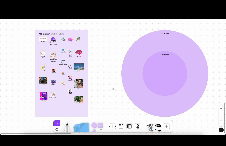
Reflect on the placement and rapport of your stakeholders within the project and with each other. Use different symbols to denote these connections, such as broken arrows or zig zags for complex relationships. The further the stakeholder is from the project, the more challenging it might be to communicate, negotiate, and collaborate. Conversely, close collaborators might make you feel more at ease, but they can also make frank, explicit conversations daunting. However, being mindful of these subtleties and aligning expectations with the rest of the project team can be truly empowering.
Commonly, there are two types of stakeholders, internal and external, but they are not that binary. We can have as many shades and concentric circles that represent different categories and different areas of influence in relation to the project as we find useful. Better yet, you can skip the external-internal play and jump right into prioritizing stakeholders. The beauty of mapping is that you can put what you like on paper (or an online whiteboard) as long as it works for the project team and the company. The more gingerly you follow one standard, the easier it is for others to hop on the project, so don’t reinvent the wheel.
Welcome to the Matrix
Another fantastic tool for mapping stakeholders is a 2×2 grid. It adapts to different scenarios, allowing you to visually map and, thus, easily compare and contrast any options and metrics you like:
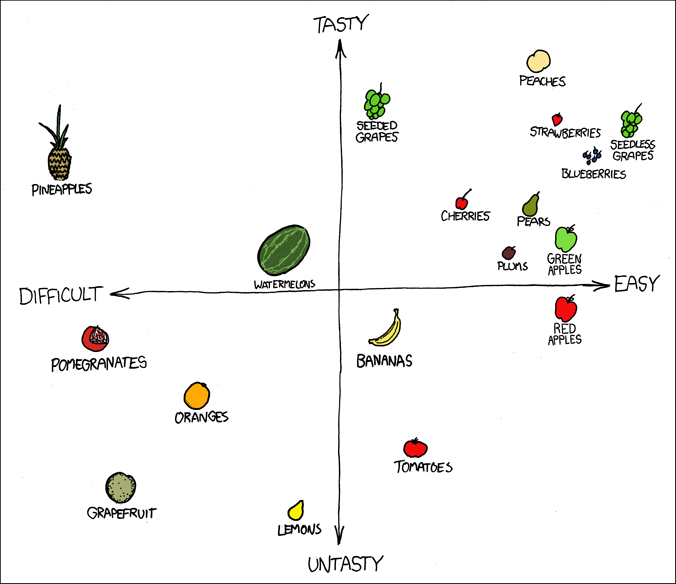
And the graphical nature invites communication and engagement among teams and stakeholders, making you an expert (or look like one) with hardly any sweat broken.
Thanks to the onion stakeholder map, we know where to look for the parts and assume how hard it would be to reach and influence them, just in case any decision or effort is required. The complexities of project communication can be overwhelming, but they alone don’t provide a comprehensive understanding of each stakeholder’s significance or engagement in the project.
For example, imagine a tax office suddenly demanding company records from the past five years. There won’t be enough coffee in the world to juggle that unexpected bureaucracy and your current project. Meanwhile, your team, despite their best intentions, won’t be able to take the load off, most likely leading to project delays.
This is where Mendelow’s Matrix (known more as the power-interest matrix) steps in, offering a structured approach to assessing and prioritizing stakeholders. It provides a reassuring framework for making informed decisions about their engagement. According to Mendelow, we can categorize our stakeholder groups by looking at two main factors: power, which refers to their ability to influence the organization’s strategy or project resources, and interest, which reflects how much they care about the organization or project succeeding. When we plot our stakeholders on the power-interest matrix, we end up with four categories, each requiring its own management strategy.
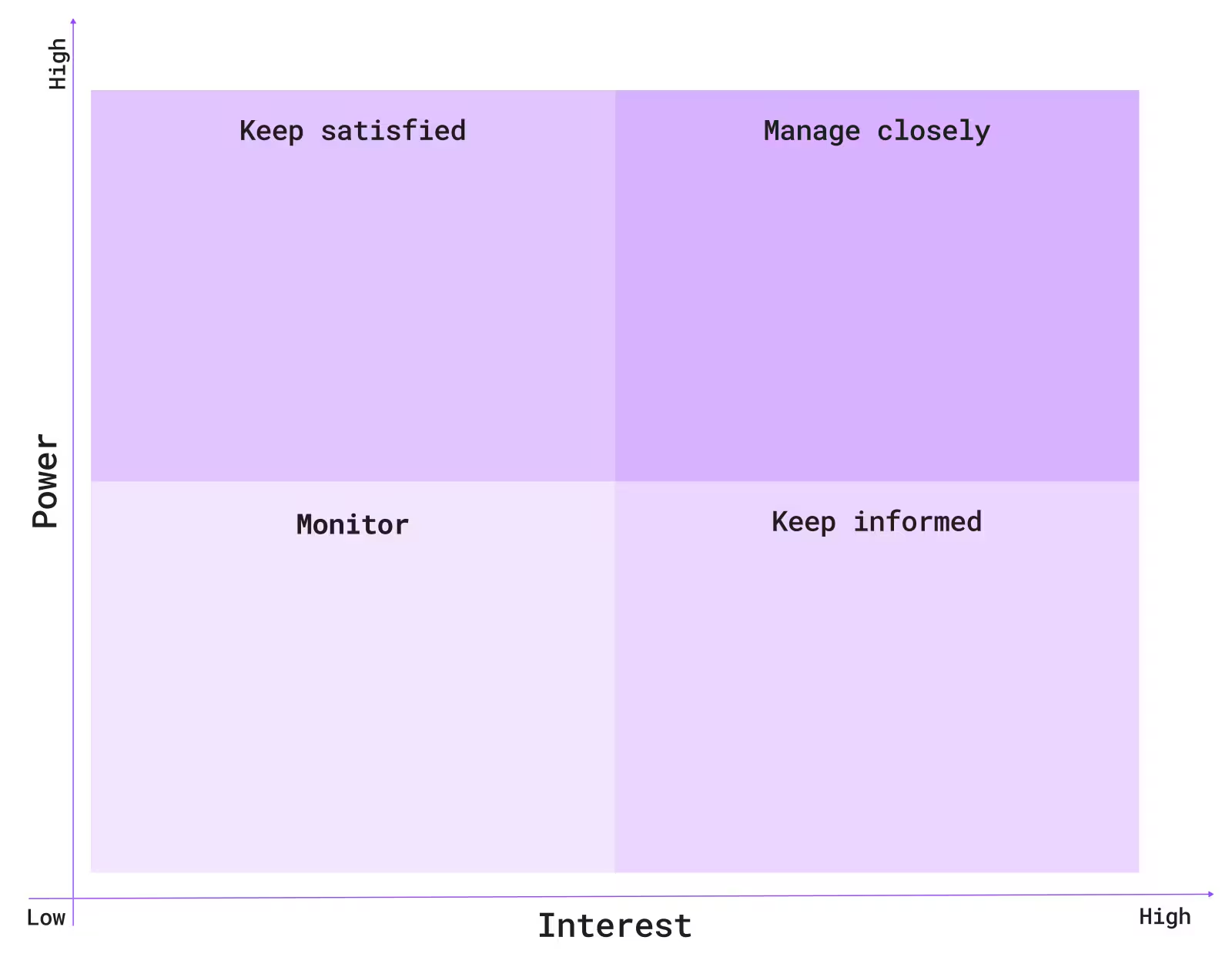
Manage Closely — Big Fish Tank
The big players are the ones to manage closely; they’re super interested in your project and have a lot of influence over how it turns out. Think of people who make resourcing decisions or your CEO, who wants to pitch in with personal ideas for a redesign. You need to keep a close eye on these folks because if you don’t, they could accidentally or intentionally mess up your project. But if you manage them well, they can become your biggest supporters, making success more likely.
Keep Satisfied — Area of Happiness
Stakeholders in the top-left quadrant, aka the latents, aren’t currently involved in your project, but they hold serious sway. It’s key to keep them satisfied because if they see your work affecting theirs, they might hop on board. Consider touching base with them to ensure their interests are taken into account, although fulfilling their requirements might be just enough to keep them happy.
Keep Informed — Knowledge Zone
Stakeholders who are interested in your project but don’t have much power should be kept in the know. Invite them to research sessions, keep them in the loop with debrief emails, and include them in design critiques whenever possible.
Monitor — Close Watch
Stakeholders in the bottom left quadrant are not worth spending too much time on — they’re not really interested in your work and don’t have much power over it. But things can change, and they might end up in a different quadrant, so keep an eye on them.
Keep it moving
You can stick to the maps only — they can handle different types and amounts of data, although not always in a way that is convenient to browse afterwards. Another option is to move your findings to a spreadsheet or a dedicated tool that supports connecting data across different documents, leaving the graphical representations for the workshop fun.
Even though the power-interest matrix provides you with a skeletal stakeholder management plan, each one might require an individual approach based on their role, company values, experience, culture, and demographics to find the best way to communicate and engage with them. Making an extra effort to figure out the whys and sweet spots of your stakeholders will help you connect with them better and take you a long, superb way.
But just as your project is constantly evolving, its stakeholder maps are a living matter, so check frequently to ensure that they match the current project landscape. Your team composition might have changed, new laws and policies could have been issued, or your tech stack could have changed. Outdated documentation makes your life harder and can be misleading, resulting in engaging wasting the time of totally wrong people.
OK, so Who’s Staking What for You?
That assembly was somewhat limited as I wanted to present a variety of forces that can influence a single endeavor without overloading the post with personal information. And surely, we’re all aiming for a good work-life separation, still, it’s tremendously naive to believe that no ego or personal experience affects our professional performance and vice versa.
That’s how I distributed the stakeholders of this text on the onion chart. Some of them might rest somewhere far away from the center of the project universe:
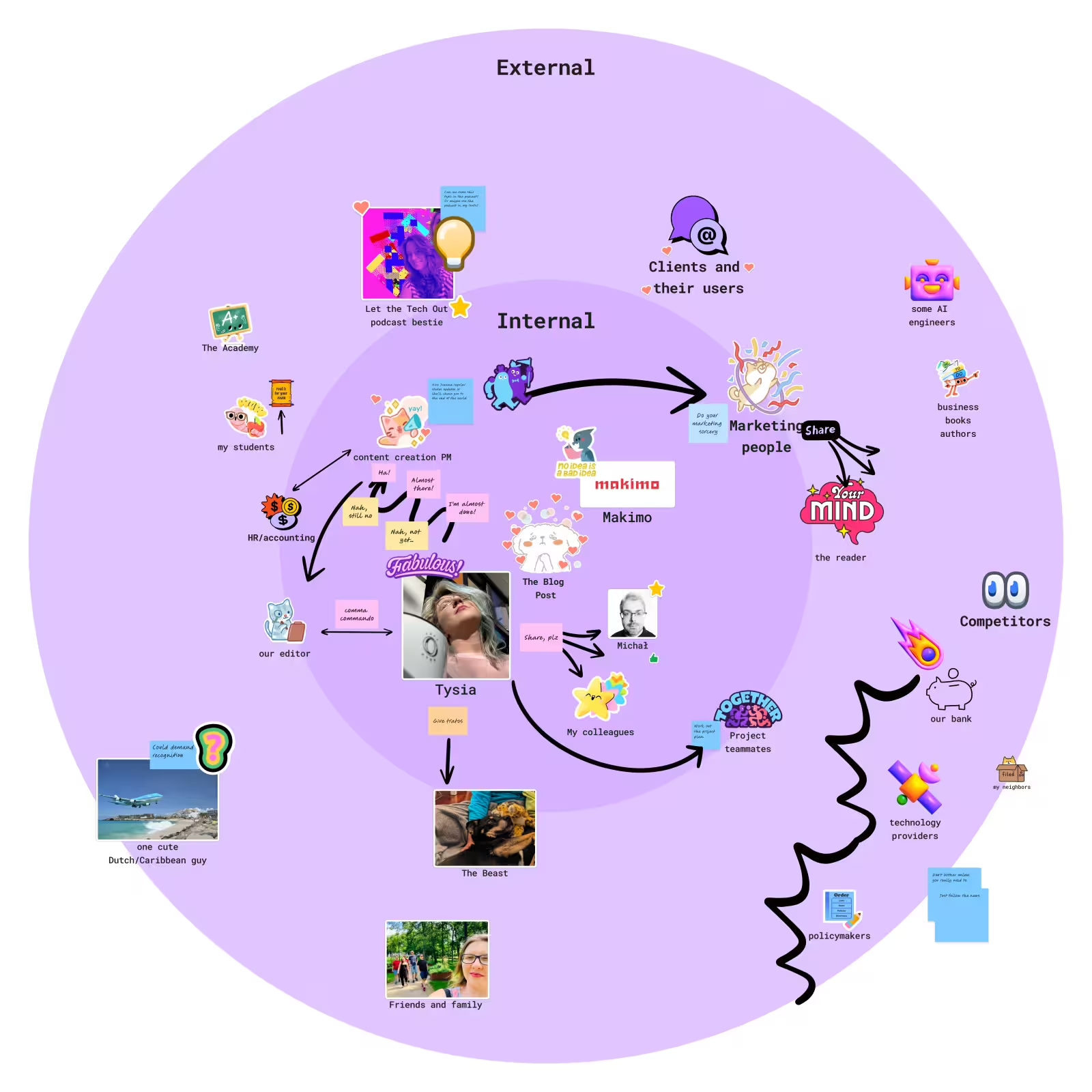
But the distance from the project doesn’t naturally relate to the influence each stakeholder has on the project; that’s much better visualized on the power-interest matrix:
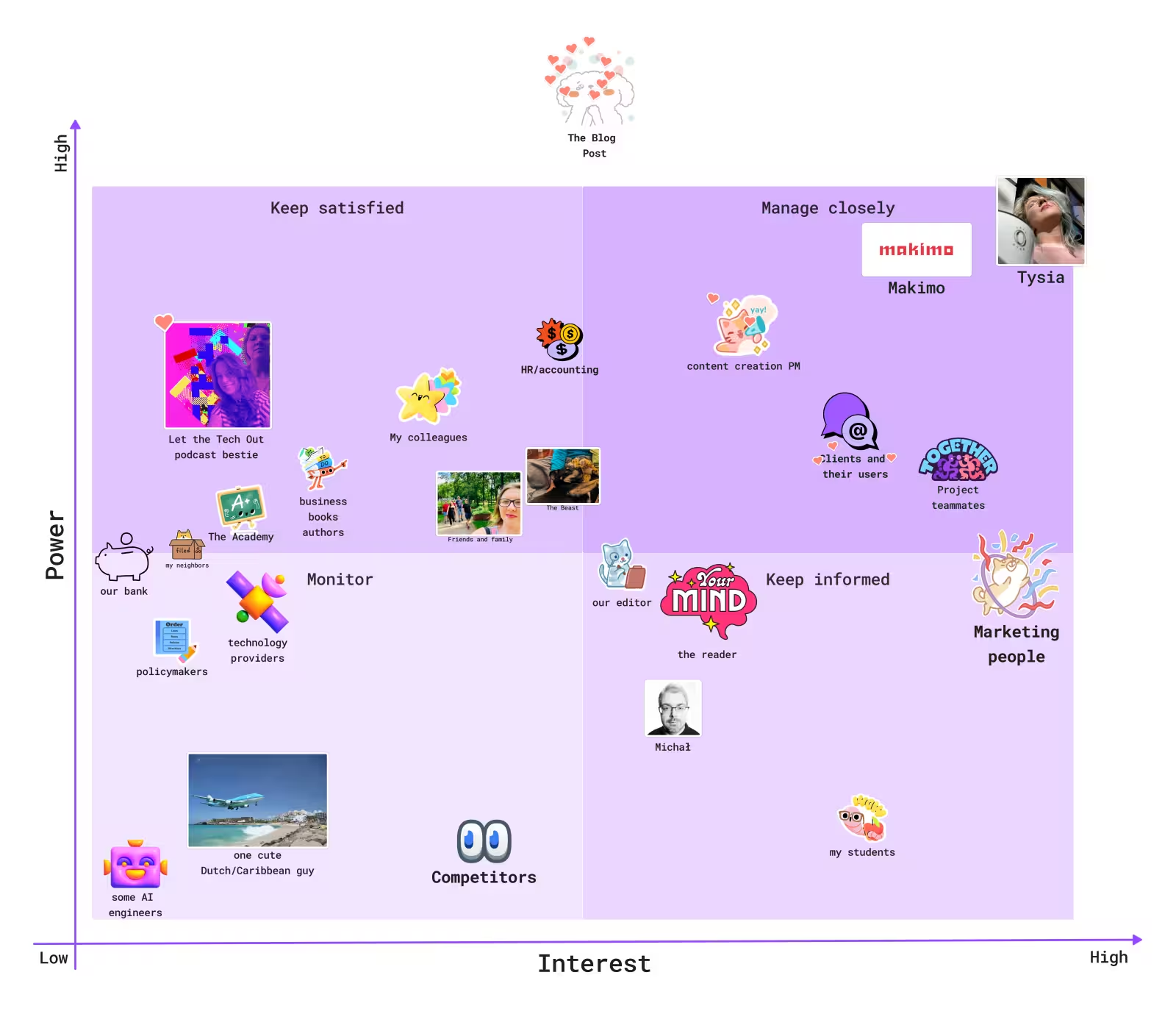
Makimo hires me, so they automatically have a lot of interest in my professional life. They also benefit from such text on many different levels, but as a brand, it shows the public that their consultants and employees care about the business, know various tools and maps, and are eager to share their knowledge with others. How about not blowing this by writing something stupid?
The owner of the content creation project is genuinely interested in my progress on the text and constantly inquires about it. Besides that, I believe she is vividly interested in me putting the old files related to the text in a very certain place on our drive. But when dissatisfied, she may also ask me to quit writing entirely, albeit this one blocks my other text.
The company’s marketing people might want to know when to publish the text and how to promote it via LinkedIn, Instagram, Facebook, or other media. They’re not likely to interfere with the substance of the text, yet they can suggest topics and forms that get better traction on the internet.
My colleagues from Makimo — even the ones who are mostly involved in producing lines of code — are genuinely interested in the business reasoning behind each project and each feature. They might want to refresh their perspective on stakeholder management or learn something new in an entertaining way.
Among my colleagues, there is Michał, whose post I mentioned above. I don’t need his permission to do so, but keeping him informed would be wise for some more shares and likes in social media.
My teammates rely on my input and my expertise either as an individual contributor or design lead. Regardless of how much I try, conceiving an article requires some time, which on the other hand can be a valuable project allotment generating a conflict of interest that needs to be managed.
Speaking of design work, there are also clients and their businesses, deadlines, projects, and goals to be met. From their point of view, I should be working on the experiences and interfaces, not on the text, so I should keep an eye on our relationship.
This brings me to HR and accounting and all the people in the company who measure profitability and the person-hours I’m spending doing commercial stuff — not the internal things. Surely, they are very important, but they are still internal things, and finance might have different metrics for their satisfaction.
We shouldn’t overlook my students, who have to learn about stakeholders during their UX research course and prepare their stakeholder map as a final assignment. With this text, they gained a single source of truth for their projects and exams — the only thing is to tell them about it. However, I don’t believe the Dean would be happy to see me writing this text while giving academic classes, so I have to be mindful about my allowance at the Academy.
Then there’s me — Tysia. This text indubitably contributes to my personal brand and the armoury of content to repurpose, so I have no problem working on it outside Makimo’s office. But I also have other passions to satisfy, a Beast to take care of, provide with snacks, cuddle and tame… Tawny the dog, that is. Count also my friends and family who might fancy seeing me at a board game, on a run, at a wine bar — anywhere clear from the text editor. One cute, Dutch/Caribbean guy mocked me recently for poor priority management due to my reluctance to make time for a reputable wine course. Teasing aside, balancing all facets of my life can be challenging, even without creating content.
And per mentioning, the cute Dutch/Caribbean guy has just joined the stakeholder bunch! I wonder if he should be informed about this recognition, though. For an incidental reader, it might be anyone.
Tawny the Beast deserves a special spot not only because I should manage his needs but also because I have an idea how to incorporate him later in some more business/design-related content.
There’s one special side project in my life: the Let the Tech Out podcast, which is both a great source of inspiration and yet another time-consuming and attention-seeking offspring. It’s another channel for letting the world know about this text as long as I keep my bestie and our amazing stakeholders happy.
It was well past midnight when I was dictating those paragraphs, snuggled sleeplessly in my bed that is flushed to the neighbour’s wall. Given that I hear all her phone calls and sounds of life, even on a noisy day, I wonder if she preaches to me about my incredible thoughts.
There are also authors of books on business development, design thinking, business strategy, and project management. Even if I don’t quote them directly, they gave me some sources of inspiration for the text and the graphics, and they should be at least recognized in the footnotes of the blog post. At the same time, mentioning them in the promo stuff might earn us some comments or shares on social media.
Then we have technology providers. They’re not involved in creating this particular blog or interested in reading the blog post. Still, we have taken into account that this text wouldn’t be able to be published or reach any audience or almost any audience without a proper CMS like WordPress or Ghost. Each one of them has some requirements regarding servers, domains, and stuff which we have to fulfill. And while we almost don’t notice the system on a daily basis, we might have trouble attaching a special type of file or encounter a server error followed by a feature request or a bug report, which, in the end, might delay the publication. Not that this particular text needs precise timing, but it illustrates the general principle.
This stakeholder spectrum is quite abstract as well, but it nicely illustrates a very special case that is often omitted: policymakers. It may happen that one day writing about stakeholders will require some sort of a certificate or a license. Such a thing will probably never happen — the worst I might be questioned about is the cookie consent. But the more complex a project involving sensitive data, medical documentation, or financial operations, the more regulations it needs to monitor and satisfy.
Our bank cannot issue a debit card for me that wouldn’t be blocked a few days after the first payment, so I’m constantly losing access to the apps and services I use to draw all the maps. I would love to satisfy the needs of… the particular entity that has a problem with me, but currently, no one knows how to fix that issue. And paying with my personal debit card instead of the company’s one (same card provider, same bank, different division) works perfectly fine. Two more blockings and I swear I’ll reveal its name…
Speaking of privacy, I wonder if this article provides any interesting addition to the training of large language models, especially in its rawest version.
Misplaced commas and articles herder, our editor is always here to catch all the funky words and smooth out any rough edges. Even though it’s his profession to make good writing even better, I always try not to be a pain in his arse and trigger as few comments as possible. But also not to exercise his patience with last-minute requests and pointless discussions (oh, thank you, that’s very thoughtful of you — the editor).
I use it as an umbrella term, but let’s not forget about listing all the competitors. Honestly, I don’t think any company, university, or freelance designer would try interrupting the publication of a business-casual text like that. Yet, corporate rivalry and espionage are a thing, and in cases of more serious business, this part of stakeholder analysis would be much more detailed.
Last but definitely not least, one of the most important stakeholders…

…is you, and you, and you…
T The reader who decided to continue reading this article up to this point instead of dropping it right after the first paragraph. You are in charge of saving this text to bookmarks, sharing it with the rest of the world, or maybe dropping us a line about what you liked (or disliked) the most in this text. To get the best results, don’t throw the users to the “keep satisfied” quadrant, but first of all, invite their reps to collaborate.
It’s lengthy but worthy
Neglecting stakeholder engagement and alignment can sometimes trigger a dead-end situation, break the project, and lower everyone’s morale. Therefore, don’t skip the discussion of every stakeholder. You’d be amazed at how many different chances, threats, and perspectives open up when you dig deeper into people and institutions related to your project and how many times you will move the position of some Post-it notes.
Last but not least, a quick stakeholder workshop is an amazing opportunity for a team to warm up before breaking the ground of serious domain research. So grab our templates if you’ve never played with stakeholder mapping and consider it the first step towards better projects.
And let me know via justyna@makimo.pl or WhatsApp if I left you humming “All I Want for Christmas is You.”
Extras
Here are all the items, for you!
- The Figma board: https://www.figma.com/board/vThiM7iImFGZrIqJjcZunv/Stakeholder-Maps-Template
- A Google Drive Directory with useful files to start drawing out stakeholder maps: https://drive.google.com/drive/u/0/folders/1grlxzDbz9lOX9hwMYDoiX5eIpw3T-ISE
- Jamie Levy – UX Strategy: Product Strategy Techniques for Devising Innovative Digital Solutions
- The Design Thinking Playbook
And if you need a development team that gives a flying flamingo about their stakeholders…
Let’s talk!Head of UX who loves making sense of noise, searching for trends and inspirations, and exploring the humane face of technology. Justyna shares her passion not only within Makimo but also as a lecturer at UEHS, Warsaw, and a co-host of the Let the Tech Out podcast. She writes her own story not only using words and pixels but also brush strokes, seams, knitting stitches, yoga asanas and running miles.




